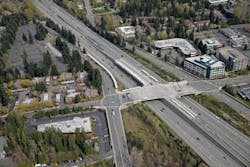New surface, new purpose
There is a theory that too many cooks in the kitchen makes for a lousy sauce.
But this isn’t strictly the case, as evidenced by a major interstate project in Washington State.
Two major challenges faced the I-405 Express Lanes project, which ran from Bellevue to Lynnwood along a 17 mile corridor. For openers, no fewer than four entities were directly involved—two divisions of the Washington State Department of Transportation (WSDOT); the design-build contractor, Flatiron West Inc.; and the tolling contractor, Telvent (now Schneider Electric)—presenting a unique contracting setup that required meticulous strategic collaboration. Additionally, the project owner wanted to transition the existing corridor, which handles 160,000 trips per day and which had undergone years of restoration and rebuilding, from a general purpose plus one high-occupancy vehicle (HOV) lane configuration to a completely operational general purpose plus express toll lanes corridor within one weekend—without closing the highway.
“In a 37-hour period [beginning on a Friday], we restriped more than 60 lane-miles and commenced tolling for WSDOT on Sunday, Sept. 27, at noon,” Flatiron’s Northwest District area manager Paul Mayo said. “It took a lot of planning with subcontractors, the WSDOT tolling division, and the tolling contractor. But it was effective. We didn’t close the highway. We left two lanes open during this unprecedented toll rollout.”
Working with tolling
Interstate 405 is a major artery that runs along the east side of Lake Washington near Seattle. The $160 million design-build project to reinvent the roadway’s purpose and capability worked to relieve congestion on 17 miles of the interstate by adding tolling infrastructure and an additional lane in each direction. The express toll lane facility uses dynamic tolling, which allows single drivers to use carpool lanes by paying an electronic toll. Tolls will dynamically increase and decrease based on traffic conditions; i.e., more traffic means higher rates. The system is designed to keep the toll lane moving at a 45-mph minimum, even at peak hours when other lanes are backed up.
The project also ran through several jurisdictions, which added to the complexity of the job. Stakeholders included the cities of Bellevue, Kirkland, Bothell and Woodinville, the utility owners in each city, WSDOT and the tolling authority.
Flatiron served as the civil contractor on the project (including toll infrastructure), and WSDOT hired a separate contractor to design, install, test and commission the toll equipment. Needless to say, these factors presented some challenges from the start.
“The two contracts were not really linked to each other and there were scope gaps that the owner had to bridge,” Mayo said. “The toll vendor was also added four months later than planned. So rather than having the toll vendor on first and knowing what their technology constraints were, it was reversed. We just had to go with the basic assumptions in our contract.”
Flatiron’s civil design advanced six months before the team knew what the toll equipment design would be. It turned out that there were several differences between the toll design and the civil design. For example, while designers thought their plans for the toll cabinet and gantry were made more efficient by being far apart, the toll vendor couldn’t have a distance greater than 300 ft between the pieces of equipment.
Although the team had to unravel the design slightly to accommodate the constraints of the tolling infrastructure, Flatiron had provided some float time purposefully built into the schedule to mitigate such impacts.
“As part of the best value proposal process, the state asked contractors to provide schedule float for use by the project in the event the separate toll vendor required extra time to on-board or roll-out their toll equipment. Flatiron provided four months of float in our schedule to mitigate potential risks,” Mayo said. “We resequenced the schedule, and it flowed. We ended up not asking for any contract time extension.”
Roadwork
The asphalt work preceding the reconfiguration of the corridor incorporated a combination of half-inch aggregate mix designs, utilizing both PG 70-22 and PG 64-22 binders. PG 64-22 was used as a base layer during the expansion work and where full-depth repairs were required, while PG 70-22 was utilized for all overlay work and for the wearing course.
I-405 is a major artery that runs along the east side of Lake Washington near Seattle. The $160 million design-build project to reinvent the roadway’s purpose and capability worked to relieve congestion on 17 miles of the interstate by adding tolling infrastructure and an additional lane in each direction. I-405 is a major artery that runs along the east side of Lake Washington near Seattle.
Jeremy Mason, P.E., regional manager for Kleinfelder’s Pacific North Region, explained that these pavements were placed “both during the standard paving window and an extension to the paving window during cold weather in non-essential locations.”
Cemex placed 211,913 tons of hot-mix asphalt (HMA) since paving began in August 2012, and utilized eight different mix designs over that time period for the HMA half-inch PG 70-22 and PG 64-22 mix pulled out of its asphalt plants in north Everett, Woodinville and Kenmore. The number of lifts varied from one to four depending upon overall thickness of the sections required. Full-depth paving was typically 0.95 ft with some sections being somewhat thinner. All but the top lift was generally HMA half-inch PG 64-22. The top lift was HMA half-inch PG 70-22 at approximately 0.15 ft. The mixes and placements were accepted by statistical analysis of the mix design test data. Tests at the plant included binder content, sieve analysis of the aggregate, voids analysis and voids filled with asphalt analysis. In the field, asphalt testing included density testing by WSDOT.
Kleinfelder performed verifications of lift thickness, temperature and placement monitoring of the mix, roll-pattern verification, tack-installation verification between surfaces and thermal imaging during placement for thermal segregation determinations. Extensive straight-edge testing on the entire wearing course area to verify surface tolerance and rideability was likewise applied. At the completion of overlay work infrared imaging (IRI) testing was performed to determine surface smoothness.
The paving width varied greatly along the roadway—anywhere from hand-paving 2-ft-wide sections to using a paver to place mix at a width of 18 ft. Throughout the construction zone, adjacent barriers dictated the number of lifts. If there was a barrier that had to sit on a certain thickness of asphalt, there was usually five lifts placed to reach final elevation. If it was just full-depth shoulder replacement/widening, it was typically accomplished in four lifts. Several 10-ft pavers (typically used singly), including a Volvo Blaw-knox paving machine, as well as smaller 8-ft and 4-ft pavers were employed, based on the fluctuating demands and allowances of the project area. The 4-ft paver used on the project was a Vögele Super 600. It was used for narrow areas, less than 9-ft wide. Cedarapids 40-ton-capacity material transfer vehicles were used whenever required per WSDOT specifications, but also many times to overcome limited truck access issues. When trucks were employed, 33-tonners were brought in.
For compaction, crews utilized a Hamm model 120-I breakdown roller, which made two to four vibratory passes, forward and back, depending on how fast the paving operation was moving. The second roller used was an Ingersoll Rand DD-118; this roller usually made three vibe passes. The final roller in the train also was an Ingersoll Rand DD-118, which made three to four static passes to achieve final compaction.
Re-engineering and innovations
A braided ramp system halfway along the route on the northbound side of the corridor provided an opportunity for innovation on the project. The new ramp separates traffic merging onto S.R. 522 from mainline I-405 from vehicles entering I-405 from a local street, providing an efficient way to enter and exit the highway by easing congestion and increasing safety. The ramp and roadway geometry was re-engineered to avoid construction of a 70-ft-high retaining wall in the middle of an area historically prone to landslides.
Cemex placed 211,913 tons of HMA since paving began on the I-405 job in August 2012, and utilized eight different mix designs over that time period.
“The original design had a large cut wall in a known slide area,” Flatiron Deputy Project Manager Chris Williams said. “We changed both the alignment of WSDOT’s project design and the future master plan design to eliminate the need to build a wall and excavate 200,000 cu yd of material. We were the only bidder to eliminate the wall, and we think it was one of the biggest changes we made at bid time to lower our price and get the job.”
This decision reduced retaining wall quantities on the project by 167,000 sq ft, cutting the earthwork by more than 65%, and eliminating a significant geotechnical risk.
In addition, the design incorporated several innovations in the proposal stage, including slightly shifting toll zones in either direction so dual toll structures could be installed, which further drove down construction costs. In total, an estimated 600,000 cu yd of excavation were eliminated, along with 162,000 ft of retaining walls—a 62% reduction. The new design replaced noise walls with a noise berm, with steeper slopes engineered to eliminate the walls.
“Because of the reduction in quantities, we were able to balance the earthwork on-site,” said Mayo. “With no off-site disposal, there was no off-site trucking. So the carbon footprint of our design was at least half of what the owner’s concept was.”
Other value engineering and design changes included using precast concrete barriers instead of cast-in-place, and a precast bridge instead of a cast-in-place bridge, which helped remove weather-related risks from the schedule.
Along the entire corridor, crews also retrofitted the roadway with advanced storm water treatment systems—essentially new ditches that include filtration to capture pollution in runoff. Crews installed 15,000 linear ft of new media filter drains and, for the first time on a WSDOT project, 10,000 linear ft of a more advanced version called a compost-amended biofiltration swale. Crews also performed extensive wetland and stream mitigation work, part of an effort by the state to improve water quality and restore salmon habitats throughout the state.
While Washington’s highway tolling system is in its infancy, WSDOT plans an additional 25 miles of tolling facilities under design-build procurements in the near future.
“We were really proud of ourselves, as far as scheming a more efficient project,” Mayo said. “It was a long project, a four-year project, and it was a tough project because of the amount of collaboration that had to happen. Nonetheless, the collaboration between WSDOT, Flatiron and the tolling vendor to ensure a successful delivery of the complete composite project is probably one of our biggest success stories.” AT


